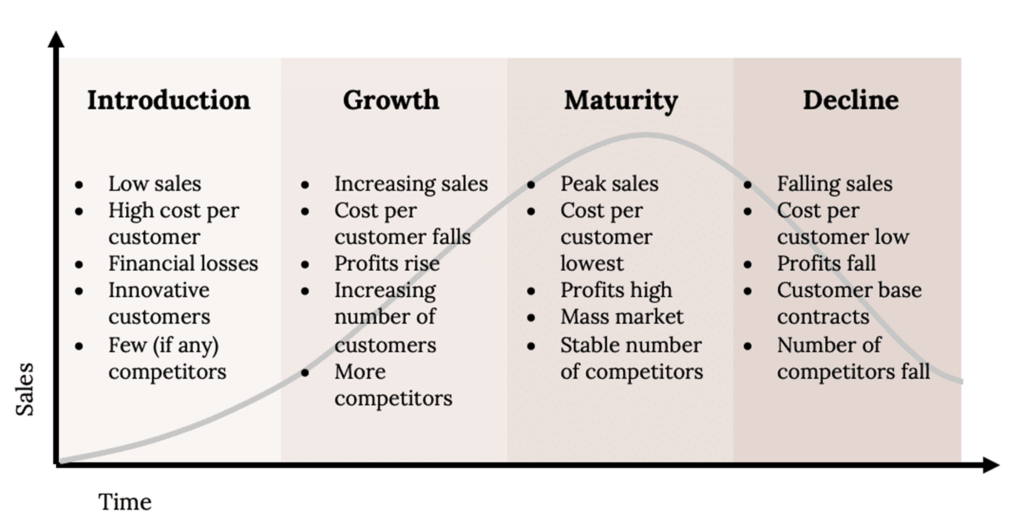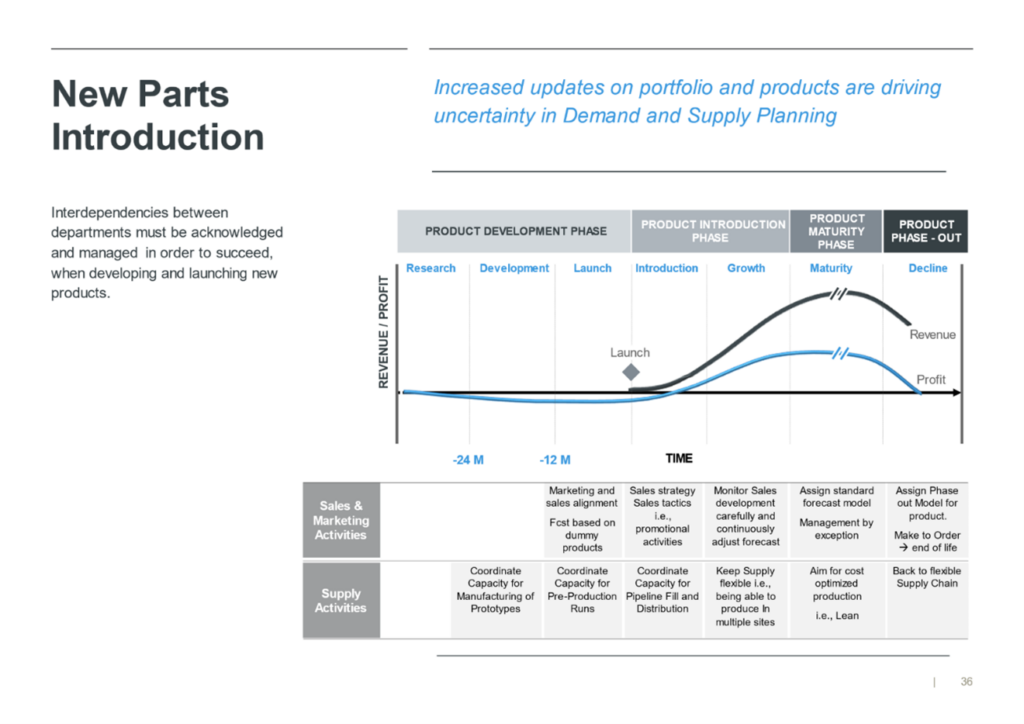Share this article
Follow us on Linkedin
In the dynamic world of business, managing the product life cycle (PLC) is a critical task for organizations seeking to maintain a competitive edge. Product Life cycle impacts finished goods as well as semifinished and raw materials. While the management of the product life cycle in the lowest level of the Bill of Material (BoM) can follow a more abrupt transition from an old product to the new one (eventually after the full consumption of the stock of the old product), the handling of the product life cycle of products sold in the market is often more challenging due to the higher external factors that can drive their demand.
Aligning product life cycle with Integrated Business Planning (IBP): A detailed strategic approach.
The PLC comprises various stages, from the launch of a new product to its eventual decline. SAP Integrated Business Planning (SAP IBP) is a comprehensive planning methodology that aligns different business functions, including research and development, sales, operations, and finance. By integrating the PLC with SAP IBP, organizations can enhance their decision-making processes, optimize resource allocation, and ultimately drive growth and profitability. In this article, we will delve deeper into the intricacies of aligning the PLC with IBP.
Understanding the product life cycle.
In literature the product life cycle describes the journey of a product from its inception to its withdrawal from the market through four main stages:
- Introduction (Phase-In): This phase marks the launch of the product, where companies focus on raising awareness, building brand recognition, and securing initial sales.
- Growth: As the product gains traction in the market, sales and profits increase rapidly. Companies must scale up production, expand distribution channels, and continue to innovate to stay ahead of competitors.
- Maturity: The maturity stage is characterized by slower sales growth and a peak in demand and profitability. Companies need to focus on cost optimization, market segmentation, and product differentiation to maintain their market share.
- Decline (Phase-Out): Eventually, sales and profits decline as the product becomes outdated or loses relevance to consumers. Companies must decide whether to revitalize the product, introduce a new version, or discontinue it altogether.
These four stages are preceded by a product development phase that starts from the conception of the new product till its final launch in the market. Within these stages additional information and knowledge is acquired about the new product and its industrialization. Also the product development phase of the product life cycle could be important for planning depending on the length of the lead time of the Time-to-Market (TTM). In fact, you could already need to forecast future sales of a launching product when only partial information is available.
Understanding the SAP Integrated Business Planning (SAP IBP) process.
SAP IBP is a collaborative planning framework that aligns various business units around a shared set of objectives. It combines strategic planning, sales forecasting, operational planning, and financial budgeting into a unified plan. IBP enables organizations to make informed decisions that support growth, optimize resource utilization, and minimize risks.
Aligning the product life cycle with Integrated Business Planning is a sophisticated approach to managing products effectively. By integrating the PLC with IBP, organizations can make better informed decisions, optimize resource allocation, and mitigate risks. This alignment will ultimately lead to improved financial performance, enhanced customer satisfaction, and a stronger competitive position in the market.
We will explore how SAP IBP can be leveraged to optimize various stages of the product lifecycle.
Aligning the product life cycle with Integrated Business Planning is a sophisticated approach to managing products effectively. By integrating the PLC with IBP, organizations can make better informed decisions, optimize resource allocation, and mitigate risks. This alignment will ultimately lead to improved financial performance, enhanced customer satisfaction, and a stronger competitive position in the market.
We will explore how SAP IBP can be leveraged to optimize various stages of the product lifecycle.
- Conception and design phase
The inception phase of a product’s life cycle is where the foundation for its success is laid. SAP IBP plays a crucial role in this early stage by facilitating a thorough analysis of market trends, customer needs, and technological advancements. By integrating insights from diverse departments such as marketing, research and development, and supply chain management, SAP IBP enables companies to make informed decisions regarding product features, design, and positioning. This collaborative approach ensures that the product is aligned with the organization’s strategic goals and resonates with the target audience.
In this initial stage, where only partial or no information is available about the industrialization of the product (meaning the required components / resources for its production) usually the best guess is to use the information from an old product the new product is eventually replacing. If that is not possible, some “dummy” master data could be required to identify through the expected lead times when components or resources required should be available.
- Development and testing
As the product moves into the development and testing phase, SAP IBP provides a robust platform for managing the complexities associated with these stages. It ensures that all stakeholders are aware of their responsibilities and deadlines, fostering a transparent and coordinated workflow. IBP tools can also assist in monitoring the development process, identifying potential bottlenecks or issues, and proactively addressing them before they escalate. This streamlined approach reduces the likelihood of delays and defects, ultimately accelerating time-to-market while maintaining product quality.
During this phase additional information like the final bill of material and required resource capacity will be known. This will allow also the creation of the required master data in the ERP system and from a planning perspective will require that the demand from the initial place holder (old material or “dummy”) is replaced by the real new product.
- Maturity and market saturation
The launch phase is where the product officially enters the market, and IBP continues to play a pivotal role in its success. By leveraging IBP’s data analytics capabilities, companies can fine-tune their marketing strategies to target the most promising customer segments. SAP IBP also aids in optimizing pricing strategies, promotional activities, and distribution channels based on real-time performance metrics. As the product reaches the market saturation stage, IBP helps in analyzing sales data to identify opportunities for product variants or updates that can reignite consumer interest and extend the product’s lifecycle.
During this phase the focus will be also in cost reduction in order to maximize profits.
- Decline
When a product reaches maturity and begins to see a decline in demand, IBP can provide valuable insights for maximizing profitability during this phase. Through detailed cost-benefit analyses, SAP IBP can guide decisions on whether to continue investing in the current product or redirect resources towards newer, more promising ventures. Additionally, SAP IBP can facilitate an orderly transition by supporting the development of successor products or exploring alternative markets for the existing product.
This phase can sometimes be identified through alerts e.g. generated when sales in the past quarter have declined of a certain percentage. In most cases enterprises have already identified new customer needs that the product cannot fulfill because of changes in market trends or technology. This internal or external factors represent the one that can trigger the conception of a new generation for the product. This phase can be planned in advance based on an expected decline of sales while product is phasing out of the market.
- Retirement
Finally, when it is time to phase out a product, IBP ensures that the process is managed smoothly and efficiently. It can help in evaluating the environmental impact of discontinuing the product, managing the phase-out of inventory, and communicating the change to customers and stakeholders. IBP can also assist in capturing lessons learned throughout the product’s lifecycle, which can be invaluable for future product development efforts.
To avoid excess of obsolete stock, companies can monitor the days of supply of phasing out products and can plan promotions or re-direct products to other markets to reduce their working capital.
In conclusion, Integrated Business Planning is a powerful tool that can significantly enhance product life cycle management. By providing a comprehensive framework for strategic decision-making and execution across all stages of a product’s life cycle, SAP IBP enables organizations to navigate the challenges of the modern business landscape with confidence and agility. Embracing IBP can lead to more successful products, optimized resources, and a competitive advantage that endures over the long term. This is also the reason why enterprises usually require planning systems that can support handling products independently of where they are in their product life cycle, reducing overall supply chain costs and inefficiencies.


